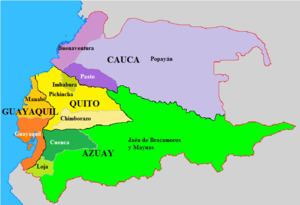6,000 4,000 Result Colombian victory | Date 1863 | |
 | ||
Similar Gran Colombia–Peru War, Colombian Civil War, Colombian Civil War of 1876, Leticia Incident, Spanish reconquest of New Gr | ||
The Ecuadorian–Colombian War, or War of the Cauca (Guerra del Cauca), occurred in 1863 between the United States of Colombia, (now Colombia and Panama), and the Republic of Ecuador. Under the Spanish Empire, Colombia and Ecuador had been part of the Viceroyalty of New Granada, and upon independence from Spain, they had co-existed as part of Greater Colombia between 1819 and 1831. Periodic border disputes, arising from the lack of clear borders under the Spanish, were combined with occasional attempts to recreate Greater Colombia to produce tensions. In 1861, conservative Gabriel Garcia Moreno (1821–75) became president of Ecuador and soon attempted to unify his country, which was sharply divided by class, regional, and language differences, by handing over much power to the Roman Catholic Church, which he considered to be the people's chief social tie to achieving a sense of nationalism. That decision deeply polarized Ecuadorian politics, as liberals generally viewed the Church as an obstacle to social and political progress.
Colombia's liberal president, Tomas Cipriano de Mosquera (1798–1878), provided aid to Ecuadorian liberals, who wished to overthrow Garcia Moreno. In 1863, he also began to push for a recreation of Greater Colombia and demanded a meeting on the border with Garcia Moreno in which the details of such an arrangement were to be decided. When Garcia Moreno did not show up, Mosquera brought an army into the border region, prompting Garcia Moreno to send a force of 6000 men force under his elderly father-in-law, General Juan José Flores (1800–1864). Flores crossed the border, leading to the December 6, 1863, Battle of Cuaspad, in which some 4,000 Colombians under Mosquera utterly defeated the invaders, about 1,500 of whom were slain or wounded and 2,000 taken captive.
Mosquera subsequently brought his army into Ecuadorian territory, reaching the town of Ibarra without encountering any resistance, but the two sides then agreed to an armistice. Subsequent negotiations led to the Treaty of Pinsaqui, signed December 30, 1863, in which the two sides agreed to a return to the prewar status quo.
Historiography
Determining exactly what happened in this rather minor war is complicated by the limited number of relevant sources, nearly all of which are heavily biased. One faction, following Augustine Berthe, idolizes Garcia Moreno as a true protector of the Catholic Church and imputes the worst possible motives to his opponents; the other demonizes Garcia Moreno and thus excuses any action by his opponents. Considerable disagreement exists as to the details of the war, even to the identity of the winner: the anti-Garcia Moreno faction claims that the Ecuadorians capitulated following the Battle of Cuaspad, but their opponents claim that Mosquera retreated after all of Ecuador rallied behind Garcia Moreno and created a new army more powerful than the first one.
